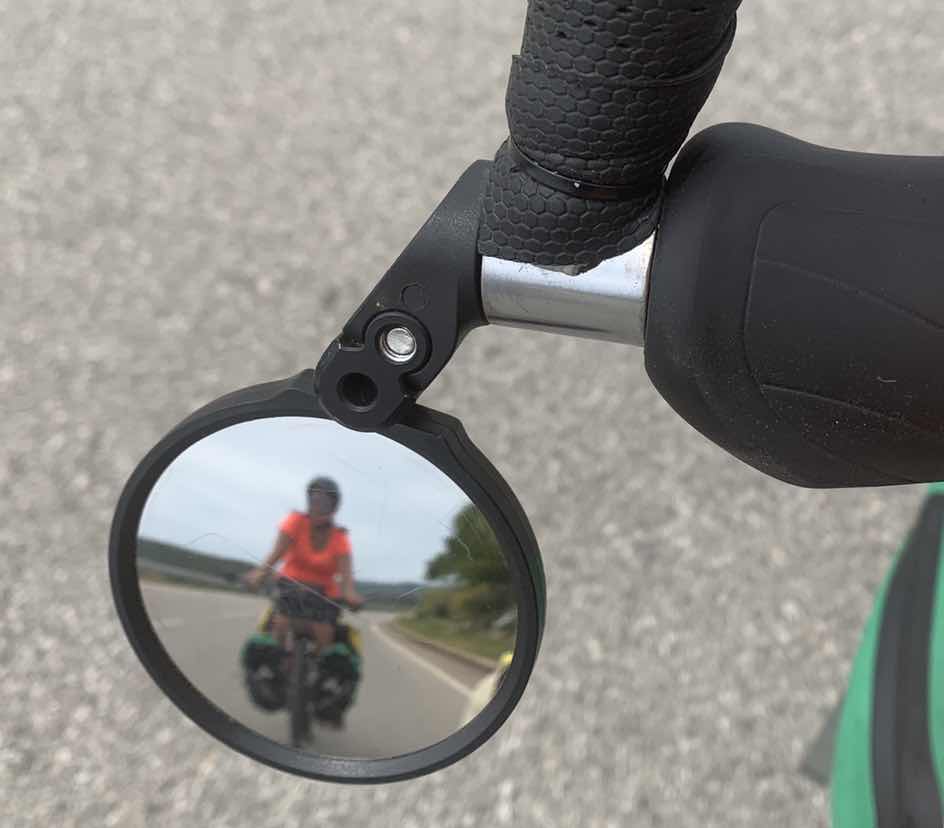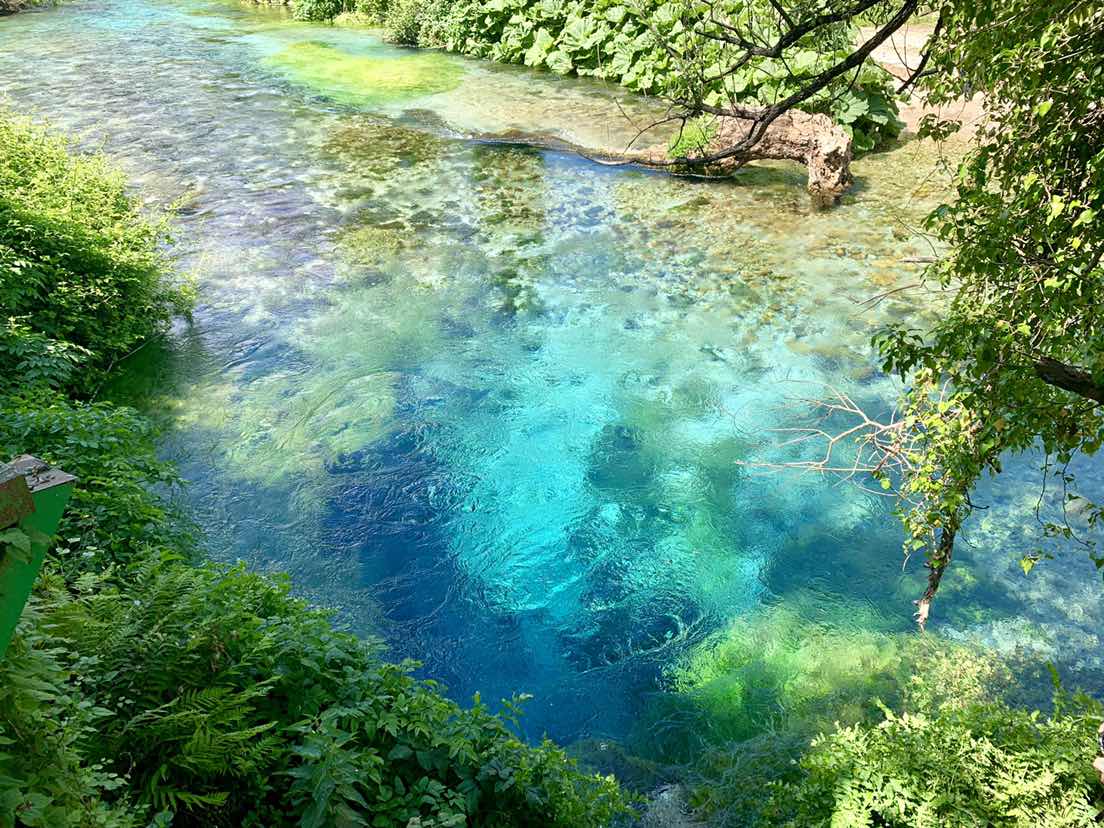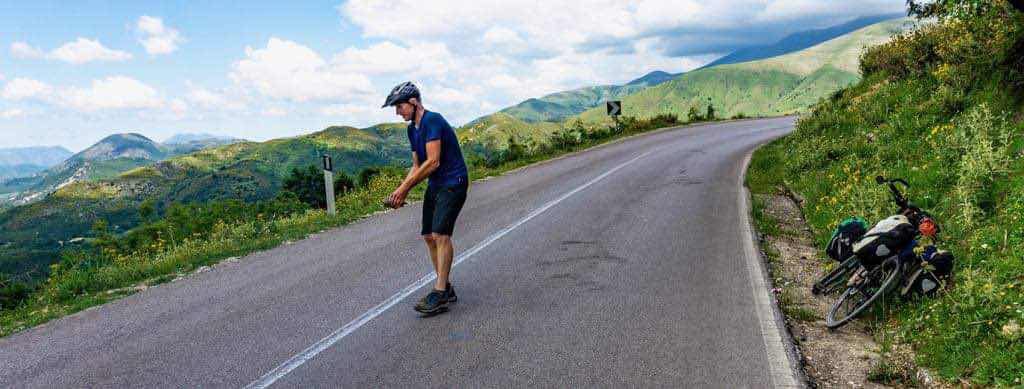Butrint National Park and Gjirokastër
By Johan - The border crossing from Greece into Albania was a breeze. Although Albania isn’t formaly part of the EU as yet, their application is in the mail so the border check point is a pretty relaxed afair. 
It was nice to be back in the saddle. The rear view mirror has been very useful, keeping an eye on approaching traffic but mostly to admire my beautiful and wonderful wife (scoring points here.) That fluorescent shirt is pretty damn useful for keeping an eye on her too, I must say 😊

Arriving to Butrint National Park on the somewhat historic looking no frills cable ferry is pretty cool. The ferry runs across the narrow Vivari Channel between the Venetian Triangle fort and the entrance of the Ancient town of Butrint; it immediately shows you there is a rich history here.

Perhaps the most striking part of the ancient city ruins of Butrint is how different civilisations have all built over the top of each other; sometimes extending the foot print and fortifications and sometimes just reusing the building materials like a stone block Lego set. We saw some of that in Greece earlier and then later in Gjirokastër as well. It started as a medieval town which was then used as the foundation for various iterations by the Greek and Roman empires, followed by yet another series of modifications by the Venetians and Ottomans later on.




There are some beautiful sandy (!) beaches in Ksamil, which was a nice change from the (mostly) pebble/rocky beaches we found on the west coast of Greece. It does seem that for the beach side hotels they cart some of the white sand in so I am not quite sure yet how wide spread these white sandy beaches really are.
 The day off in Ksamil was also to mentally prepare for our upcoming first big climb of the bike trip. In the end the stretch from Sarandë on the coast over the saddle (570m) to get to the Gjirokastër valley wasn’t all that bad. An easy grade for the first part into the valley followed by large stretches with a 10% gradient and switchbacks. Deborah passed her first climbing test with flying colours, I must say.
The day off in Ksamil was also to mentally prepare for our upcoming first big climb of the bike trip. In the end the stretch from Sarandë on the coast over the saddle (570m) to get to the Gjirokastër valley wasn’t all that bad. An easy grade for the first part into the valley followed by large stretches with a 10% gradient and switchbacks. Deborah passed her first climbing test with flying colours, I must say.


We dropped by the Blue Eye spring on the way up. Not the best tourist attraction but still pretty amazing how much water pumps out of this spring. They are not quite sure how deep this hole really is but divers have managed to go down to about 50 meters. The very clear water is channeled down the valley through a man made channel to generate power and to irrigate the fields in the coastal valley below.
I managed to fit in another Turtle “rescue” on the way up as well. This poor fellow was desparetly trying to make it across but got stuck in the middle of the road as a large string of traffic passed by. I sped his travels up with a short air lift.




The evenings were spent on the terras of our Guest house - enjoying the owner’s home made wine and the sunset over the valley. A great way to end this visit before we face the 100km biking out of the valley trying to avoid too much of that motorway traffic tomorrow.

First impressions of Albania are good. Once again, as was the case in Greece, the people are very friendly and appreciate the effort of us trying to utter “hello” (përshëndetje) and “thank you” (faleminderit). It breaks most stern faces into a friendly smile, followed by their much more provicient English “hello”. English isn’t very common for people over 35 or so. Most younger people speak English pretty well though so when you get lost; just ask a teenager.
Arriving to Butrint National Park on the somewhat historic looking no frills cable ferry is pretty cool. The ferry runs across the narrow Vivari Channel between the Venetian Triangle fort and the entrance of the Ancient town of Butrint; it immediately shows you there is a rich history here.
Perhaps the most striking part of the ancient city ruins of Butrint is how different civilisations have all built over the top of each other; sometimes extending the foot print and fortifications and sometimes just reusing the building materials like a stone block Lego set. We saw some of that in Greece earlier and then later in Gjirokastër as well. It started as a medieval town which was then used as the foundation for various iterations by the Greek and Roman empires, followed by yet another series of modifications by the Venetians and Ottomans later on.
We hung out in the nearby town of Ksamil for an extra day to take in some of the pre-season Albanian Rivera feeling.
There are some beautiful sandy (!) beaches in Ksamil, which was a nice change from the (mostly) pebble/rocky beaches we found on the west coast of Greece. It does seem that for the beach side hotels they cart some of the white sand in so I am not quite sure yet how wide spread these white sandy beaches really are.
We dropped by the Blue Eye spring on the way up. Not the best tourist attraction but still pretty amazing how much water pumps out of this spring. They are not quite sure how deep this hole really is but divers have managed to go down to about 50 meters. The very clear water is channeled down the valley through a man made channel to generate power and to irrigate the fields in the coastal valley below.
I managed to fit in another Turtle “rescue” on the way up as well. This poor fellow was desparetly trying to make it across but got stuck in the middle of the road as a large string of traffic passed by. I sped his travels up with a short air lift.
After a thrilling steep downhill (10% all the way), riding to Gjirokastër through the valley along SH4 was a bit of a bummer. It’s a busy highway with fast moving trucks. There is a wide enough cycle lane for the first part but closer to Gjirokastër it narrows to a skinny two lane road where trucks end up brushing the hair on you arms.
The arrival to Gjirokastër was therefore a welcome change despite the steep uphill into town. The climb into the old city centre presented us with a great view of the old town and castle.


The city is famous for its many old buildings built with the Ottoman building style. The (steep) roads are made of cobble stones; in some areas with cool colour patterns. The buildings are a combination of stone, wooden support structures and stone roofing which must weigh an absolute tonne. I guess that’s probably why many of the roofs have some interesting dips.
The city is famous for its many old buildings built with the Ottoman building style. The (steep) roads are made of cobble stones; in some areas with cool colour patterns. The buildings are a combination of stone, wooden support structures and stone roofing which must weigh an absolute tonne. I guess that’s probably why many of the roofs have some interesting dips.
The Castle sits above the city and again is an example of multiple civilisations building on eachothers work, in this case after the Ottoman Empire it was also used by the Germans in WO2 and more recently as a prison by the Albania Communist regime. The castle is in surprising good shape despite the dozen or so times it has been defended, captured and recaptured between 1100 and 1945.
The evenings were spent on the terras of our Guest house - enjoying the owner’s home made wine and the sunset over the valley. A great way to end this visit before we face the 100km biking out of the valley trying to avoid too much of that motorway traffic tomorrow.
Comments
Post a Comment